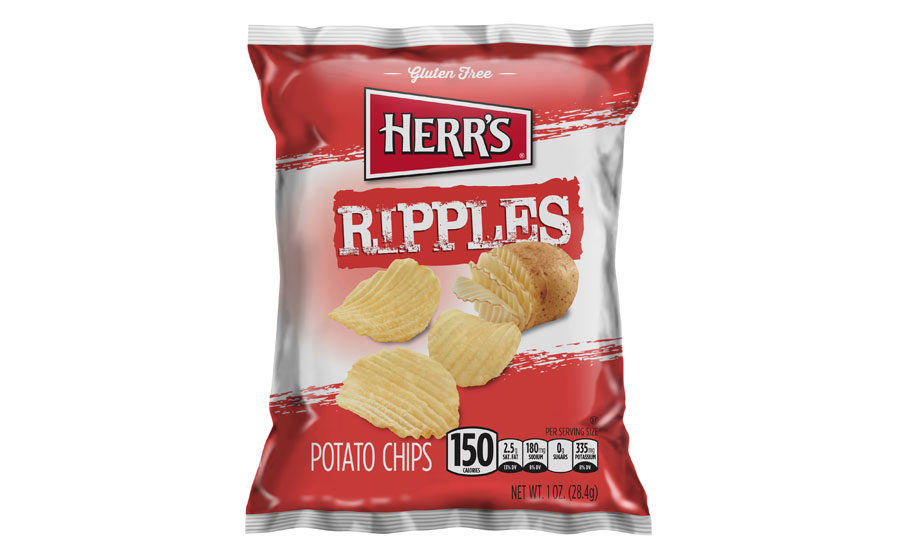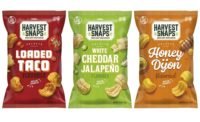When James S. Herr, known as Jim, entered the potato chip industry with Herr’s Potato Chips in 1946 by purchasing a potato chip operation in Lancaster, PA, he established a legacy of enduring tradition guiding waves of ensuing generations. He cultivated deep company roots in traditional values and strong business integrity, seeking to live his life with “zest and purpose—with flavor,” as he noted in his 2012 autobiography, “Life with flavor,” published just after he passed away in 2012.
Today, the company is known as Herr Foods Inc., based in Nottingham, PA with office, production, and warehouse space that combine in that location for 450,000 square feet. The company is still family owned and operated, with over 1,600 employees across the Mid-Atlantic region—and making some inroads in national and international markets. The legacy begun 75 years ago endures, with 13 members of the Herr family involved with the business—and the third generation poised for increased leadership.
“Herr Foods isn’t just a family business,” says son Ed Herr, chairman and CEO. “It’s a business family.”
Farm-bred beginnings
“My father grew up on a family farm in Willow Street, PA, and you were required to work on the farm until you were age 21,” says Ed. “Then, when you turn 21, you could either continue to work on the farm, or you could explore other options. And by the way, you didn’t get paid for working on the family farm, except that when you turn 21, you are entitled to a used car.”
Jim’s job on the farm consisted of taking care of laying hens in a big barn by himself—solitary work that didn’t suit his personality. “My father took his used car and decided that at this point, he would like to work with people,” says Ed. “He saw an advertisement in the Lancaster newspaper that Verna’s Potato Chips was for sale for $1,750.” So he borrowed the money from a lawyer who employed his fiancé Miriam Esther Hershey—known as “Mim” (the two would marry the following year). They changed the name to Herr’s Potato Chips and started making their potato chips, sold in the local Lancaster market, and door-to-door.
As noted in his autobiography, Jim’s payment of $1,750 included:
-
Two iron kettles, which would each hold 100 pounds of lard
-
A potato peeler that would hold 10 lbs. of potatoes
-
A three-potato slicer
-
A 1936 Dodge panel truck in “fair condition”
Jim would also have one part-time employee to help launch his entrepreneurial venture.
In his first foray outside of Lancaster, Jim secured distribution for his chips in a Wilmington, DE market. “He would drive back and forth to Wilmington selling potato chips,” says Ed. “This was before big supermarkets. It was a different way of shopping. People were getting milk, bread, and other goods delivered to their door. But there were also these ‘mom-and-pop’ stores where he could sell potato chips. So that’s where it all started.”
Together, Jim and Mim would do “whatever it takes” to grow the business over the years as they raised their five children, June, J.M., Ed, Gene, and Martha. They leaned into their shared faith and farm-bred values forming the firm foundation of a company that would grow to support thousands of families through the years—and delight millions of customers around the world.
Early moves
Not long after getting its start, Herr’s endured its first catastrophe when the production facility succumbed to fire.
“In 1951, Dad was coming back from Wilmington,” says Ed. “He was a mile away from the factory when he saw smoke on the horizon. The traffic had stopped, and he started getting out and asking people what was going on.” They said they had heard the potato chip company was on fire.
“The good news was that nobody was hurt, and his apartment—that was connected to the factory—was safe, as were Mother and the two young children,” says Ed. “But Dad and Mother had to make a decision. Did they want to continue to keep this potato chip company? Or, with the insurance money, they could buy their own farm and just get back into farming. Obviously, they made a decision to continue to work with people, to continue to grow this potato chip business.”
The search for a new location brought Jim and Mim to Nottingham, PA, where they would purchase 37 acres of land for $18,000—the location of Herr’s headquarters today.
In terms of facility size, Herr’s was still modest. “In 1952, everything would have been housed in the same building, which was 4,500 square feet,” says grandson Jeremiah Thomas, senior vice president, manufacturing. But Herr’s was poised for strong growth.
The operation needed new equipment, and Jim decided to advance production through acquisition of an automatic cooker that could process 100 pounds of chips in an hour—a nice increase from the 40 pounds per hour coming out of each kettle. To finance the move, they borrowed money from family members and banks. Six months after the fire, Herr’s was back in business.
For Jim and Mim, the move to Nottingham was also spiritual. “One of the deciding factors that brought them to Nottingham was the calling they had from their church to be one of the young couples that would move to the area to help start a new church,” says Ed.
Herr’s endured a natural disaster in the fall of 1954, when Hurricane Hazel tore through the area, inflicting significant damage to the building—and to Jim himself, who sustained several broken ribs and a broken ankle as the hurricane battered the production facility where he was finishing up for the day when the storm hit. Luckily, the employees had already gone home for the day, and his nearby home was intact, his family safe.
Strong momentum
Through the years, the Nottingham location provided arterial highway access for direct-store delivery (DSD) growth throughout the Philadelphia metropolitan area. “ACME Markets were coming on board, and A&Ps were starting to surface, and we began doing business with those kinds of retailers,” says Ed. “Dad introduced a potato chip that we campaigned as lively, light, and delicious. He took pride in making a chip that was light in color and very fresh—with great customer service. That’s what gave us a point of differentiation and an opportunity to grow our business in the Philadelphia market.”
Jim maintained an enterprising approach toward business. In 1964, Herr’s started packaging chips in 20-oz. “King Style” cardboard barrels, which helped better protect the chips. They were a big hit with customers.
In 1966, Herr’s saw its annual sales hit $1 million for the first time.
Progress continued—including distribution reach, with New Jersey added in 1968. Iconic East Coast convenience retailer Wawa started carrying Herr’s chips around that time, as well—a relationship that continues today.
Over the next two decades, Herr’s would grow from running 35 delivery routes to nearly 300, opening 12 new branches and hiring over 500 people. From 1988 to 2008, the company added another 200 routes, opened another eight branches, and hired another 500 people.
Herr’s product mix was growing, as well. In the 1970s, the company diversified into areas of “allied snacks” like extruded cheese curls, and then popcorn.
In 1979, Jim was named president of the Potato Chip Institute, the organization that would eventually become SNAC International. This name change reflected the growing, diversified snack foods industry in America.
In 1981, Herr Foods added pretzels to its product mix. In 1983, corn product processing came next, making corn chips and tortilla chips. That year, the company changed its name, from Herr’s Potato Chips to Herr Foods Inc., to reflect its increasingly diverse product mix. Herr’s was evolving in step with the industry.
By 1996, sales had grown to over $100 million—and then to $150 million by 2000. Distribution by this time was international, with a new presence in Latin America.
Herr Foods has followed a highly organic style of growth through the years, guided primarily by ongoing market development and expansion. Select development milestones include:
-
1963: new production facility constructed in the center of the Nottingham property
-
1968: added space for more cooking, packing, and potato storage capabilities
-
1977: purchased Carroll’s Potato Chips in Chillicothe, OH
-
1980: built new plant in Nottingham
-
1990: corporate offices and Visitor Center construction in Nottingham
-
1993: warehouse additions in Nottingham
-
1999: addition to Nottingham plant, including more production capabilities
-
2008: Nottingham Plant 2 constructed
-
2013: acquisition of Silk City Snacks in Clifton, NJ
The company began introducing automation in the 1980s and has continued investing in efficient equipment and processes through the years—including some recent projects completed before the COVID-19 pandemic. “Automation is part of our culture,” says grandson Troy Gunden, president. This aspect of company culture has helped Herr Foods strategically position itself well before the industry even began talking about workforce shortages.
Construction of Nottingham Plant 2 in 2008 was a major move for Herr’s. The $20 million, 70,000-square-foot facility houses production for baked potato crisps and extruded cheese curls and balls. The facility has a lots of flexibility in the production lines. “That’s what the whole plant is built around: flexibility,” says grandson James Herr, known as Jim, senior vice president, marketing and R&D.
Herr Foods offers a wide range of different pack sizes, as well as different displays, case packs, notes Troy. So production flexibility is a must. “We try to provide whatever the customer needs.”
Jeremiah notes Herr Foods has made strategic investments into technology just as much to improve quality as production flexibility and efficiency. “A lot of the investments into the production side really help with efficiency, but it’s about providing consistent products as much as anything else.”
Market diversity
Herr Foods serves 10 states in the Mid-Atlantic region through DSD, including regional and national chains, and a significant number of independent stores.
“We also dabble in some national distribution, which is where we sell products directly to some of the key retailers on a national scale,” says Ed.
International plays a role, too. Distribution now goes to 49 countries around the world.
“We also have a little bit of vending business,” says Ed. “Then we also have a few select private label customers that we work with.”
This diversity brings market strength.
“We want to be in every channel, and that’s a benefit with DSD, as you’re able to service almost every single channel through that network,” says Troy. Then anyone they can’t service through DSD can go straight through the warehouse.
“We want to be in every channel, and that’s one nice area with DSD” says Troy. “We can service almost every single channel through that network.”
The discount channel is seeing growth, notes Jeremiah. And convenience continues to grow, too.
“We also place value on the non-franchised accounts—the ‘mom and pop’ markets,” says Troy.
The cumulative strategy is working. “Our company is currently experiencing good demand for our products,” says Troy.
And one of the contributing factors to the current momentum stems from how Herr Foods has weathered the ongoing COVID-19 pandemic.
Shining in a crisis
The Herr family has a history of perseverance, and the ongoing COVID-19 pandemic has posted its fair share of crises to the industry.
First and foremost, notes Ed, Herr Foods was just thankful to keep working. “That, in and of itself, kept us healthier—just to be busy. So we were thankful to be busy, thankful to have jobs.”
It was also a time where the culture of Herr Foods could shine, says Ed. “It was a time when our people were proud to be part of our company, proud to work together. We were able to have good communication and keep them up to speed with everything that was going on in the world around us. We were trying to ease their anxiety with answers to questions and keeping them in the loop. We developed a system where I could text every employee in the company with updates on COVID. In an environment where everybody was hearing different things on the news, getting bombarded with negatives, we just tried to stay calm, to stay positive.”
Company culture really comes through when under stress, says Jim. “You can have a good culture when everything’s going well. But when you have stress put into the environment, that’s when your culture gets tested. Across the company, we all just kind of dug in—a willingness to help out other team members, a willingness to accept the safety parameters that we put into place. People agreed that we were doing the right thing. That we have a responsibility to the broader community to keep producing food,” he says.
“A lot of the people who work in our manufacturing team came from our sales team,” says Jeremiah. “They were volunteering to work on Saturdays and Sundays, saying that we needed to keep our sales team full of products. There was a sense of pride that the whole group wanted to see our products on the shelves during that time—continuing today.”
Managing waste
Herr’s receives around a dozen truckloads of potatoes per day, which equates to half a million pounds of potatoes. Upon delivery, the potatoes unload directly into the abrasive scrubbing and cleaning process.
Once they come through the cleaning process, the potatoes are hand-inspected, mainly to look for potatoes that are too large. The slicers use a centrifugal system, with the blades changed every couple of hours.
The sliced potatoes get an additional rinse before going into the fryer, drawing off any residual starch. Herr Foods gathers the starch water, filters out the starch, and sells it to a local paper company.
The wastewater goes to nearby Herr Angus Farms, home to 500 head of cattle, used for irrigation. The cattle also receive “steer party mix” in their feed—specially developed with a nutritionist—that includes byproducts from snack production, like potato peelings and out-of-specification chips.
“Our grandfather loved farming,” says Jim. “We purchased the farm in the 1980s, long before ‘going green’ became fashionable. We’re able to recycle a lot of our byproducts made in the plant on the farm. So it’s a perfect tie-in for our business and culture.”
Part of it is stewardship, says Jim. “We have the privilege of getting water from the ground. We have wells, and underground aquifers provide the water we use. We want to be good stewards, using the water for what we need to do—such as washing the potatoes—but then we want to clean it and put it back onto the soil to replenish the earth.”
This creates a self-contained closed loop, says Jeremiah. “We have two lagoons that can hold 13 million gallons of wastewater.” After removing the starch, we spray-irrigate the field so it falls back down into the water table. That water table feeds back into an underground reservoir that we constantly have access to, and to date, it has never left us dry.”
Operational details
Nottingham production operates two continuous fryers for potato chips. They fry for 3 to 5 minutes at 350˚F using cottonseed or corn oil. The finished chips get a dusting of dendritic salt—an ingredient that doesn’t clump and provides even coating across the chips. Current production at Nottingham can handle 15,000 lbs. of potato chips per hour.
Nottingham also operates eight batch fryers for the kettle chips, which fry for a longer amount of time at a lower temperature. Herr Foods is currently installing two more batch fryers to meet increased demand.
The facility features an optical sorter at the end of the continuous chip lines to remove any chips with discolorations or other defects. At set intervals, QA/QC staff test the potato chips for a full range of product dynamics, including color, flavor, and density.
To best manage resources, a heat-recovery system collects excess heat from the ovens and fryers, feeding to a heat exchanger, recycling the heat from production and greatly cutting back on energy costs.
Herr’s uses a dedicated, adjacent facility for its pretzel production. Four pretzel ovens operate, yielding an average of about 4,000 lbs. per hour. Herr’s pretzel formulations include a natural sourdough process.
The Herr’s product mix
Herr’s history of flavor innovation began in 1958 when the company introduced its first flavored potato chip—barbecue. Throughout the years, seasoning ideas for Herr’s products have come from a variety of sources, including suppliers, internal R&D, and even employee contests.
Lately, Herr’s has done a lot of work to address the trend in spicy new products, says Jim. “The bold flavors have done well. We’ve done some limited-time offers where we see an opportunity to create really unique, bold flavors that will be in stores for a quarter and then transition to something else. It’s a great way to test products, to see what takes. We have a few that we’ve repeated because they did so well.”
In May 2021, Herr’s launched its “Flavor Mix Mystery” taste test, with a chance to win $10,000 and a year’s supply of Herr’s. The company combined three classic chip flavors into one never-tasted-before flavor. With 15 Herr’s flavors to choose from, that equates to 2,500 possible flavor combinations, made from:
-
Sour Cream & Onion
-
Barbecue
-
Salt & Vinegar
-
Cheddar & Sour Cream
-
Honey BBQ
-
Red Hot
-
Fire
-
Ketchup
-
Old Bay
-
Salt & Pepper
-
Creamy Dill
-
Jalapeño
-
Mesquite BBQ
-
Boardwalk Salt & Vinegar
-
Cheddar Horseradish
In September, Herr’s announced that the three classic Herr’s flavors that make up the Flavor Mix Mystery chip were Ketchup, Creamy Dill, and Jalapeño.
Herr’s also released two other Flavor Mix varieties this past summer: Barbecue and Salt & Vinegar, and Cheddar and Sour Cream & Onion. Other recent innovations include a Game Day Flavors line of snacks, launched in September 2021, featuring Buffalo Wing and Tailgate Tacos potato chips, and 7 Layer Dip cheese curls.
“We’ve also worked at developing some of the better-for-you items under our Good Natured brand,” says Jim. “We’ve seen some nice increases in distribution there.”
Herr Foods takes two distinct paths toward meeting the needs of shoppers seeking better-for-you salty snacks. “You have your go-to Herr’s brands, with some products that have less sodium or less fat, and fewer calories,” says Jeremiah. “And then there are the Good Natured products that have more nutritional value.”
Also, in March, to commemorate Herr’s landmark 75th anniversary in 2021, the company released an LTO Homestyle kettle-cooked potato chip with special packaging.
Forever good
At the core of Herr Foods is the notion of “Forever Good,” a trademarked slogan that follows the brand on product packaging through marketing campaigns and in company literature.
“It encompasses the cultural aspect of our business,” says Jim. “We are a family business and intend to keep it that way. It’s an ode to our heritage. Also, on the quality side, it represents consistency—that our consumers can trust us. We’ve long been a part of their lives—and their parents’ and even grandparents’ lives. The consistency, quality, and dependability of the brand is what we mean when we say ‘Forever Good.’”
It’s also about good work. The J.S. Herr Family Foundation, established in 1988, continues the Herr family legacy of gifting to charitable causes, providing annual financial support to several nonprofit organizations.
As Ed says, regarding the responsibility of maintaining his parents’ legacy, “We can’t fill their shoes, but we can sure try to keep a shine on them.”
“Part of our legacy is giving back to the local community,” says Jim. “We’re one of the larger employers in our region, and we feel like it’s our responsibility to give back to a community that supports our Herr Foods family.”
As part of its 75th anniversary celebration this year, Herr’s donated $25,000 to the Salvation Army’s food assistance program, providing meals to over 6,000 families in Philadelphia. And in April and May, Herr’s launched the #ChipInChallenge campaign, focusing on “random acts of kindness.” To jump-start the “chip it forward” movement, Herr’s surprised consumers across Philadelphia neighborhoods by buying their lunch, including a bag of Herr’s chips, and encourage them to join the #ChipInChallenge by paying it forward to a fellow Philadelphian.
“We have good energy around why we do what we do,” says Ed. “It’s really the reason that we want to keep growing. We want the opportunity to work together as a family, but we also want the opportunity to help other families. We want to help our employees more. We want to help their families more. We want to help the communities where they live more. It’s probably the biggest motivation to make more profit. That’s what made my parents tick, and it’s what drives us today.”
To help foster a desire for volunteerism, Herr’s employees receive one paid week per year designed to donate their time to a cause, a mission trip, or a similar service-oriented endeavor.
An enduring legacy
In the end, a company’s success boils down to the quality of your team. “I think we have one of the best teams in the industry,” says Ed.
“I think that our business has built a culture of transparency and trust and that bridges collaboration,” continues Ed. “It brings teamwork, it brings support for one another, and it brings an atmosphere where people are free to share their ideas—where they’re free to share their criticisms and critiques. It’s just like any other organization—it could be a family, it could be a marriage, it could be a nonprofit. It’s a living, breathing organization. The healthier, the more vibrant you can make that organization, the better.”
It’s about preserving the enduring legacy from Jim and Mim Herr. “If we live out those values, with the team and their families, valuing people, making them part of it, then we’ve accomplished something,” says Ed.
Herr Foods has maintained a thread of strong company leadership through the years. Ed notes that his brother, J.M., just retired, and he held roles as either chairman, CEO, or president for 40 years. “He was the leader of our business the second generation for all these years.”
The Herr family does quite a bit of work in succession planning, says Jim. “We’re currently making the transition to the third generation. And we’re actually working on a project for the fourth generation, where we all get together at annual meetings and talk about how we want this business to run.”
When someone in the family expresses an interest in company leadership, they get involved with a path toward that goal. “If you want to be in leadership, you get an education,” says Ed. “You need to have outside experience. You need to start at the bottom, work your way up, and prove yourself.”
Herr Foods is committed to staying family-run, says Ed, which is rare today in our industry.
“That family-focused, inclusive culture is what made us who we are. “We’re proud of our team,” says Ed, “and passionate about learning more.”
REFERENCES:
- “Life with Flavor—A Personal History of Herr’s,” Jim Herr, with Bruce E. Mowday and June Herr Gunden, 2012
-
Kyle Grasty, Host and Tour Guide, Herr Foods, Nottingham, PA,
AT A GLANCE:
Company: Herr Foods Inc.
Headquarters: Nottingham, PA
Website: www.herrs.com
Number of employees: 1,600+
Products offered: Potato chips, pretzels, cheese curls and balls, popcorn, tortilla chips, corn chips
Brands: Herr’s, Good Natured Selects, Go Lite!, Flavor Mill, Cheyenne Brand
KEY PERSONNEL
Ed Herr, Chairman and CEO
Troy Gunden, President
Ramiro Fernández, CFO and Senior Vice President of Finance
Bob Landis, Senior Vice President, Human Resources
Daryl Thomas, Senior Advisor to CEO and Strategic Opportunities
Jim Herr, Senior Vice President, Marketing and R&D
Jeremiah Thomas, Senior Vice President, Manufacturing
Dan Sifer, Senior Vice President, Supply Chain





















